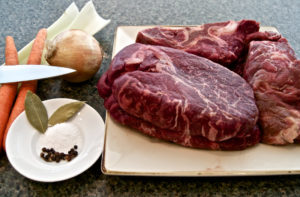What You Need to Know About Preventing Listeria Infections
Certain foods – including ready-to-eat refrigerated foods, unpasteurized (raw) milk, and foods made with unpasteurized milk – often may be contaminated with Listeria monocytogenes (LM), the third leading cause of death from food poisoning.

Pregnancy
The Risk
Certain foods – including ready-to-eat refrigerated foods, unpasteurized (raw) milk, and foods made with unpasteurized milk – often may be contaminated with Listeria monocytogenes (LM), the third leading cause of death from food poisoning. These foodborne bacteria can grow at refrigerator temperatures and can cause an illness that in most healthy people is unpleasant but not serious. But in people who are at high risk, LM can cause an illness called listeriosis which can be severe and even lead to death. The people at high risk include pregnant women and their unborn babies, newborns, older adults, and other persons with weakened immune systems, such as those with HIV/AIDS, cancer, diabetes or kidney disease, and transplant patients.
While a pregnant woman may have only a mild, flu-like illness, or may not feel sick at all, listeriosis can lead to miscarriage, death of the unborn baby, a low-birth weight infant, health problems for the newborn, or even infant death. That’s why reducing risks from Listeria is so important.
Pregnant women are about 10 times more likely than the general population to get a Listeriainfection.
Pregnant Hispanic women are even more likely than non-Hispanic pregnant women to get a Listeria infection. This is probably caused by eating traditional soft cheese, such as “queso fresco,” and other traditional foods made with milk that is unpasteurized. Brands of these traditional foods made with pasteurized milk are available in stores and online.
How to Reduce Your Risk from Listeria: 3 Easy Steps
There are three very simple things you can do to help prevent illness from Listeria:
1. Chill at the Right Temperature
The right temperatures slow the growth of Listeria. Put a refrigerator thermometer in the refrigerator and adjust the refrigerator temperature control, if necessary. Put a second thermometer in the freezer.
Your refrigerator should register at 40°F (4°C) or below and your freezer at 0°F (-18°C).
2. Use Ready-to-Eat Foods Quickly!
Use ready-to-eat, refrigerated foods by the Use By date on the package. The longer they’re stored in the refrigerator, the more chance Listeria has to grow.
3. Keep the Refrigerator Clean
Clean your refrigerator regularly.
Wipe up spills immediately. This is particularly important, so Listeria doesn’t have a place to grow and then spread to other foods.
Clean the inside walls and shelves with hot water and a mild liquid dishwashing detergent, rinse, then dry with a clean cloth or paper towel.
Temperature Check!
Use an appliance thermometer for your refrigerator and, if possible, one in your freezer:
- Put the thermometer in the middle of the refrigerator. After 5 to 8 hours, if the temperature is above 38° to 40°F (3° to 4°C), adjust the refrigerator temperature control to a lower setting. Check again after 5 to 8 hours.
- Put the thermometer between frozen food packages in the freezer. After 5 to 8 hours, if the temperature is above 0° to 2°F (-18° to -17°C), adjust the freezer temperature control to a lower setting. Check again after 5 to 8 hours.
To Eat or Not to Eat?
Choosing the right foods and preparing them safely helps reduce the risk illness from Listeria for at-risk people.
High Risk Foods |
Lower Risk Foods |
Hot dogs and luncheonmeats – unlessthey’re thoroughlyreheated |
Hot dogs and luncheonmeats that are heated to an internal temperature of 165°F measured with a food thermometer. |
Soft cheeses, such as Feta, Brie,Camembert, “blue-veinedcheeses,” or “queso blanco,” “queso fresco,” or Panela– that are made with unpasteurized milk. |
Soft cheeses labeled “Made with pasteurized milk” |
Refrigeratedpâtés or meat spreads |
Canned or shelf-stable* pâtés or meat spreads |
Refrigeratedsmoked seafood – unlessit’s ina cooked dish,such as a casserole. (Refrigerated smoked seafood, such as salmon, trout, whitefish, cod, tuna, or mackerel is most often labeledas “nova- style,” “lox,” “kippered,” “smoked,” or “jerky.” These types of fish are found ingrocery store refrigerator sections or delicounters or soldat delicatessens.) |
Canned or shelf-stable* smoked seafood. |
Unpasteurized milk or foods that contain unpasteurized milk |
Pasteurized milk and foods made with pasteurized milk |
* – Foods that can be safely stored at room temperature, or “on the shelf,” are called shelf stable. |
|
Follow These Steps For Food Safety
Clean: Wash your hands before, during and after handling food. Wash utensils, cutting boards, and any surfaces that food touches after each use. Wash fruits and veggies — but not meat, poultry, or eggs.
Separate: Use separate cutting boards, plates, and utensils for raw (uncooked) produce and for raw (uncooked) meat, poultry, seafood, and eggs. Keep meat, poultry, seafood, and eggs separate from all other foods while shopping and in the refrigerator.
Cook: Only a food thermometer can make sure meat, poultry, fish, and casseroles are cooked to a safe internal temperature. For example, internal temperatures should be 145°F for whole meats (allow the meat to rest after cooking for 3 minutes) and fish, 160°F for ground meats, and 165°F for all poultry. Eggs should be cooked until the yolk is firm.
Chill: Use appliance thermometers to be sure your refrigerator is at or below 40ºF and your freezer is 0ºF or below. Between 40ºF and 140ºF is the Danger Zone, when bacteria can multiply rapidly. Generally, the more bacteria, the more likely someone will get sick. Most refrigerators have just a colder/ warmer adjustment, so the only way to know is to put a thermometer inside.
About Foodborne Illness: Know the Symptoms
Consuming dangerous foodborne bacteria will usually cause illness within 1 to 3 days of eating the contaminated food. However, sickness can also occur within 20 minutes or up to 6 weeks later. Although most people will recover from a foodborne illness within a short period of time, some can develop chronic, severe, or even life-threatening health problems. Foodborne illness can sometimes be confused with other illnesses that have similar symptoms. The symptoms of foodborne illness can include:
- Vomiting, diarrhea, and abdominal pain
- Flu-like symptoms, such as fever, headache, and body ache











